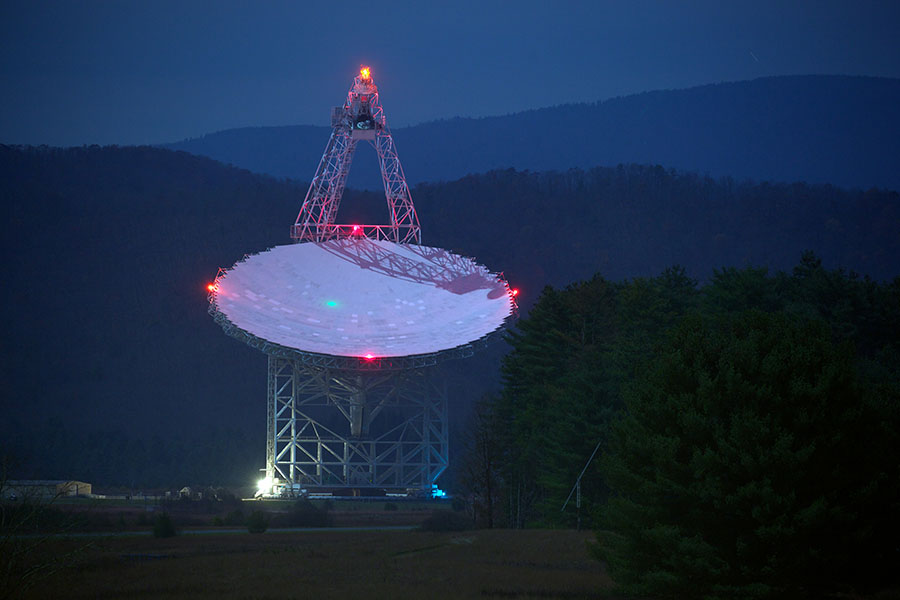Five Things Friday: From Harvey to aliens
Photo by Jiuguang Wang, published Oct. 26, 2012, Some rights reserved, license link: https://creativecommons.org/licenses/by-sa/2.0/legalcode, Original link to work: https://www.flickr.com/photos/jiuguangw/8129557462/in/photolist-doo7cQ-oK8zC7-garxQW-oJWmrP-rKvgsk-fMbrRY-S5S2yi-cJm4dW-PyAxE-jB9jg-PyAxh-3gYf-PyAxy-PyAxC-3gYb-6wMCjn-2gDvX7-ce9wvh-cSmLUw-8MBpFy-5WtC8D-DAAtbF-jB9hs-3x6wm2-pyBmdp-RGe3aU-9uVnSJ-jB9ik-jB9g6-pwKHst-jB9cC-9LQEsD-azwzqA-oSrKQT-jB9eT-jB9dM-2N8ugR-pwR8oA-6y37Sm-8Xg7aW-rz9mm-48SQLM-pwR81w-dmLrjz-azwy1G-5WtTdc-cfErXu-weekPm-S5S2FT-cfErR1, The Robert C. Byrd Green Bank Telescope located in Green Bank, West Virginia.
08/26/17: Hurricane Harvey hits Texas
Heavy rain, winds, and floods displaced hundreds of thousands of Texans as Hurricane Harvey hit the coast of the state. However, there are more fears than flooding: experts fear that Harvey will also result in gas explosions on the many chemical plants located in Texas. Reports of popping noises heighten fear of explosions that can lead to intense fires and noxious gas. Estimating the cost on economy at $190 billion, Dr. Joel Myers, AccuWeather’s founder and president, believes that Harvey is likely the most expensive natural disaster in United States history. In response to Hurricane Harvey, however, civilians and celebrities across the nation have already raised millions in response to the disaster.
08/27/17: NASA’s competition takes determines winner
In a competition hosted by NASA, thousands of teams across the nation have produced a 3D-printed Habitat Challenge design aimed to create a substantial household not only for Earth but also beyond Earth. The competitors were required to create a structurally sound design from their own printer and the construction materials that would be tested for various factors, such as compression, to determine scores. Fosters + Partners team of Chattanooga, Tennessee won the first place prize of $250,000 with their design of living quarters suitable for deep space exploration. Jim Reuter, deputy associate administrator for NASA’s Space Technology Mission Directorate, states that innovations such as these are crucial for phase 2 of “preparing the way for deep space exploration.”
08/28/17: North Korea flies missiles over Japan
As North Korea fired a missile over Japan, citizens were alerted with messages to occupy a sturdy building or to go underground early Monday morning. In response to the ballistic missile, Japanese president Shinzo Abe issued a speech regarding it as a grave threat to the security of the country. Although Japan has been at the end of the missile threats for the past 18 months – with some landing in Japanese waters – a missile has never flown over the land as it had this week. Japan, however, does have a ballistic missile defense system already in place, similar to that of the United States, in place for dire situations.
08/29/17: Amazon works to cut Whole Foods prices
Amazon has bought the grocery store chain Whole Foods for $13.4 billion with hopes of transforming the upscale chain into a more frequent shopping habit for consumers. After attempting – and failing – to create a market where consumers can buy fruits, meats, and vegetables online, Amazon is tackling its grocery war using the Whole Food purchase. According to Mark Braun, a senior vice president of Food Marketing Institute, the largest barrier to Whole Foods customers was the price. By cutting as much as 43% on certain items, such as organic Fuji apples, Amazon is not only showing that it wants to cater towards more individuals, but that it is also working to dominate the food industry as well – through both traditional and e-commerce markets.
08/30/17: FRB reveal possibility of intelligent alien life
The Green Bank Telescope in West Virginia has been conducting data for Breakthrough Listen Initiative, a project dedicated to finding signs of intelligent alien life, for over 15 years. The astronomers at Breakthrough were able to record fast radio bursts (FRB) from a mysterious source in a dwarf galaxy three billion light-years away over a course of few hours; this phenomenon is especially intriguing because FRBs usually last a few minutes at most, making this account the longest ever documented. Vishal Gajjar, a Postdoctoral researcher at the University of California where Breakthrough is located, and his team have been able to collect over 400 terabytes of data of the FRBs. He states there are several explanations for short FRBs- such as a collapse of a dwarf star. However, FRBs of such duration observed is not common, driving the Breakthrough Listen team to rank it among the “considered to be most significant” events.
Your donation will help support The Lambert Post, Lambert High Schools student-run newspaper! Your contribution will allow us to purchase equipment and cover website hosting costs.









Bonnie Espy • Sep 4, 2017 at 12:17 pm
Berry continues to stay on top of the weekly headlines! Great job!